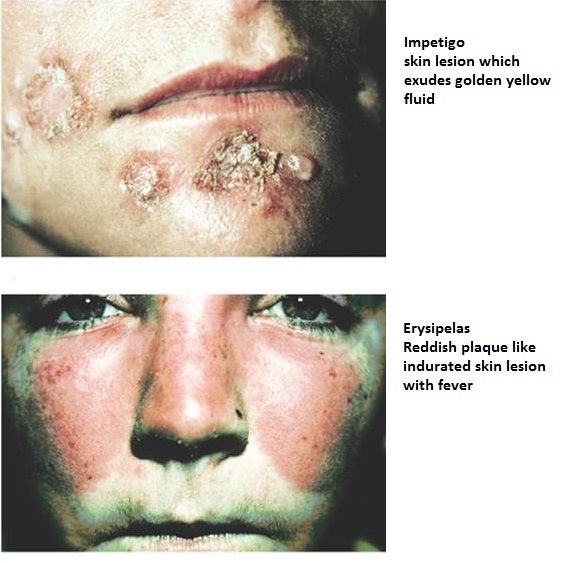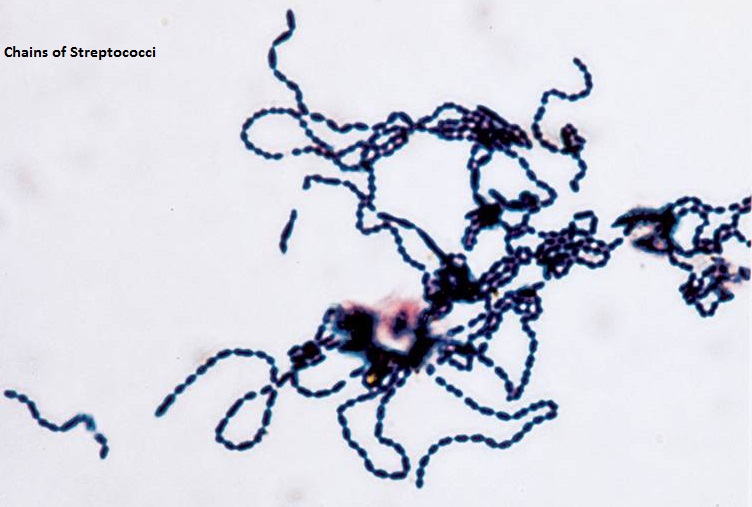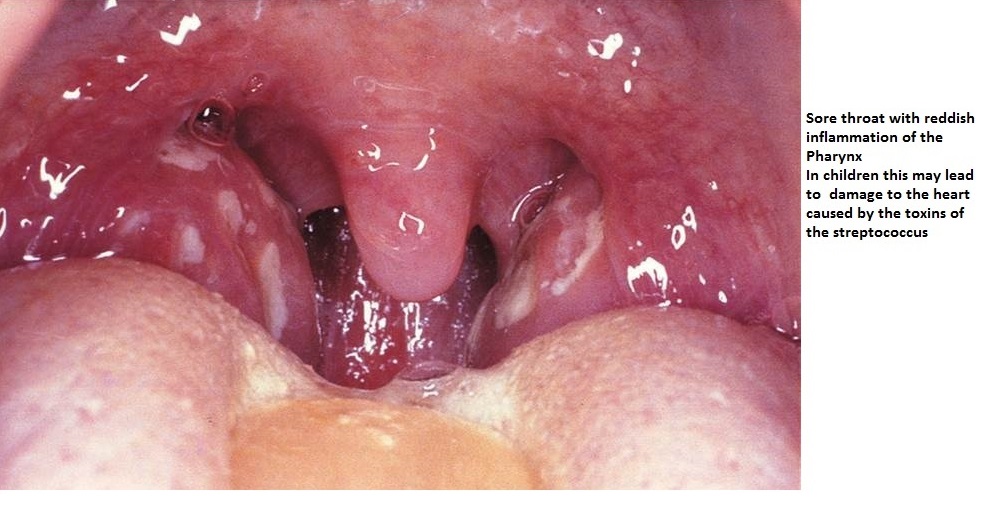Streptococci
General Characteristics of Streptococci
Gram-positive
Spherical/ovoid cocci
Arranged in long chains; commonly in pairs
Non-spore-forming,
Nonmotile
Can form capsules and slime layers
Facultative anaerobes
Do not form catalase, but have a peroxidase system
Most parasitic forms are fastidious and require enriched media.
Small, nonpigmented colonies
Sensitive to drying, heat and disinfectants
25 species
Lancefield classification system based on cell wall
Ag 17 groups (A,B,C,
.)
Another classification system is based on hemolysis reactions.
b-hemolysis A,B,C,G and some D strains
a hemolysis S. pneumoniae and others collectively called viridans
Certain Species
S. pyogenes
S. agalactiae
Viridans streptococci
S. pneumoniae
Enterococcus faecalis
Most serious streptococcal pathogen
Strict parasite
Inhabits throat, nasopharynx, occasionally skin
Produces surface antigens:
C-carbohydrates protect against lysozyme
Fimbriae - adherence
M-protein contributes to resistance to phagocytosis
Hyaluronic acid capsule provokes no immune response
Virulence Factors of b-hemolytic : S. pyogenes
Extracellular toxins:
streptolysins hemolysins; streptolysin O (SLO) and streptolysin S (SLS) both cause cell and tissue injury
pyogenic toxin (erythrogenic) induces fever and typical red rash
superantigens strong monocyte and lymphocyte stimulants; cause the release of tissue necrotic factor
Extracellular enzymes
streptokinase digests fibrin clots
hyaluronidase breaks down connective tissue
DNase hydrolyzes DNA
Epidemiology and Pathogenesis
Humans only reservoir
Inapparent carriers
Transmission contact, droplets, food, fomites
Portal of entry generally skin or pharynx
Children predominantly affected by cutaneous and throat infections
Systemic infections and progressive sequelae possible if untreated
Scope of Clinical Disease
Skin infections
Impetigo (pyoderma) superficial lesions that break and form highly contagious crust; often occurs in epidemics in school children; also associated with insect bites, poor hygiene, and crowded living conditions
Erysipelas pathogen enters through a break in the skin and eventually spreads to the dermis and subcutaneous tissues; can remain superficial or become systemic
Throat infections
Streptococcal pharyngitis strep throat
Systemic infections
Scarlet fever strain of S. pyogenes carrying a prophage that codes for pyrogenic toxin; can lead to sequelae
Septicemia
Pneumonia
Streptococcal toxic shock syndrome
Long-Term Complications of Group A Infections
Rheumatic fever follows overt or subclinical pharyngitis in children; carditis with extensive valve damage possible, arthritis, chorea, fever
Acute glomerulonephritis nephritis, increased blood pressure, occasionally heart failure; can become chronic leading to kidney failure
Group B: Streptococcus agalactiae
Regularly resides in human vagina, pharynx and large intestine
Can be transferred to infant during delivery and cause severe infection
Most prevalent cause of neonatal pneumonia, sepsis, and meningitis
Pregnant women should be screened and treated.
Wound and skin infections and endocarditis in debilitated people
Group D Enterococci and Groups C and G Streptococci
Group D:
Enterococcus faecalis, E. faecium, E. durans
normal colonists of human large intestine
cause opportunistic urinary, wound, and skin infections, particularly in debilitated persons
Groups C and G:
common animal flora, frequently isolated from upper respiratory; pharyngitis, glomerulonephritis, bacteremia
Identification
Cultivation and diagnosis ensure proper treatment to prevent possible complications.
Rapid diagnostic tests based on monoclonal antibodies that react with C-carbohydrates
Culture using bacitracin disc test, CAMP test
Treatment and Prevention
Groups A and B are treated with penicillin.
Sensitivity testing needed for enterococci
No vaccines available
α-Hemolytic Streptococci: : Viridans Group
Large complex group
Streptococcus mutans, S. oralis, S. salivarus,
S. sanguis, S. milleri, S. mitis
Most numerous and widespread residents of the gums and teeth, oral cavity and also found in nasopharynx, genital tract, skin
Not very invasive; dental or surgical procedures facilitate entrance
Clinical conditions associated
Bacteremia, meningitis, abdominal infection, tooth abscesses
Most serious infection subacute endocarditis blood-borne bacteria settle and grow on heart lining or valves
Persons with preexisting heart disease are at high risk.
Colonization of heart by forming biofilms
S. mutans produce slime layers that adhere to teeth, basis for plaque. Involved in dental caries
Persons with preexisting heart conditions should receive prophylactic antibiotics before surgery or dental procedures.
Streptococcus pneumoniae: The Pneumococcus
Causes 60-70% of all bacterial pneumonias
Small, lancet-shaped cells arranged in pairs and short chains
Culture requires blood or chocolate agar.
Growth improved by 5-10% CO2
Lack catalase and peroxidases cultures die in O2
All pathogenic strains form large capsules major virulence factor.
Specific soluble substance (SSS) varies among types.
84 capsular types have been identified
Causes pneumonia and otitis media
Epidemiology and Pathology
5-50% of all people carry it as normal flora in the nasopharynx; infections are usually endogenous.
Very delicate, does not survive long outside of its habitat
Young children, elderly, immune compromised, those with other lung diseases or viral infections, persons living in close quarters are predisposed to pneumonia
Pneumonia occurs when cells are aspirated into the lungs of susceptible individuals.
Pneumococci multiply and induce an overwhelming inflammatory response.
Gains access to middle ear by way of eustachian tube
Cultivation and Diagnosis
Gram stain of specimen presumptive identification
a hemolytic; optochin sensitivity
Quellung test or capsular swelling reaction
Treatment and Prevention
Traditionally treated with penicillin G or V
Increased drug resistance
Two vaccines available for high risk individuals:
capsular antigen vaccine for older adults and other high risk individuals-effective 5 years
conjugate vaccine for children 2 to 23 months
* * * * * * * *





